Tetras are one kind of popular freshwater fish, coming from South America, Central America, and Africa. Most of them are easy to keep. Tetras fish are small – generally, 1.5-2 inches and one tetra can produce 50 tetra fry on average. After about 8–12 months, tetra fry will get mature. In this article, let’s explore further and understand the popular tetra aquarium.
Content Table
Colorful & Active Tetras Fish Species Profile
Tetras belong to the Characidae, Alestiidae, or Lebiasinidae family, with a surprising amount of genera, more than 150. One tip here, you can tell a difference between tetras from the Characidae family and other fish. That is the small adipose fin between the dorsal and caudal fins, which is the unique feature of tetras from the Characidae family. Next, this segment will bring an introduction to some tetras fish.
1. Neon tetra
| Brief description | Silver-white abdomen and light-blue back A blue horizontal strip from the nose to the base of the adipose fin A red strip from the middle of the body to the base of the caudal fin Transparent fins and tails |
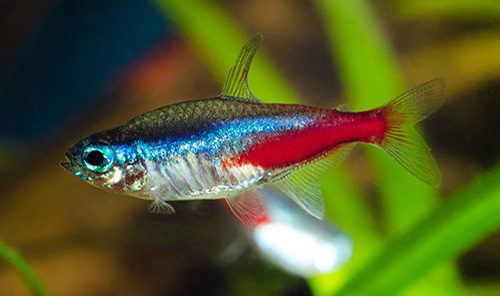 |
|
| Phylum | Chordata | Class | Actinopterygii |
| Order | Characiformes | Family | Characidae |
| Genus | Paracheirodon | Species | Paracheirodon innesi |
2. Congo tetra
| Brief description | Iridescent colors change from the top to the belly, respectively are blue, red, yellow-gold, and blue Tail fin: grayish-violet with white edges |
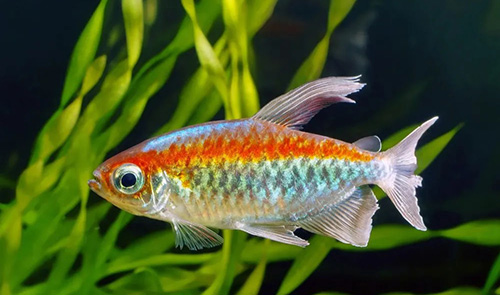 |
|
| Phylum | Chordata | Class | Actinopterygii |
| Order | Characiformes | Family | Alestidae |
| Genus | Phenacogrammus | Species | Phenacogrammus interruptus |
3. Lemon tetra
| Brief description | Body color: translucent yellow Anal fin: transparent with black edges Dorsal fin: black with a yellow central patch Tail fin: most are transparent, while some possess gunmetal-blue luster Eyes: the upper half of the iris is dark red |
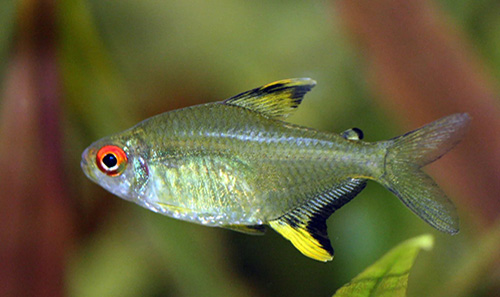 |
|
| Phylum | Chordata | Class | Actinopterygii |
| Order | Characiformes | Family | Characidae |
| Genus | Hyphessobrycon | Species | Hyphessobrycon pulchripinnis |
4. Diamond tetra
| Brief description | Body color: silver Dorsal and anal fins: purple Eyes: red marks above the pupil A dark band along the midline of the body Male ones possess more bright colors |
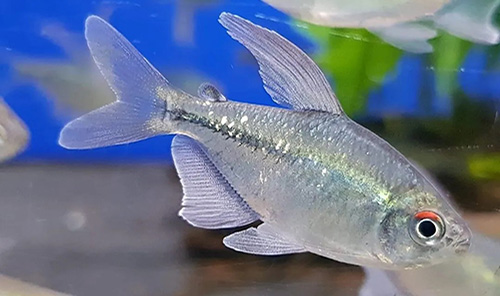 |
|
| Phylum | Chordata | Class | Actinopterygii |
| Order | Characiformes | Family | Characidae |
| Genus | Moenkhausia | Species | Moenkhausia pittieri |
5. Emperor Tetra
| Brief description | Long and slim body shape A black line placed within a blue strip from eyes to tail Dorsal, pectoral, and anal fins: yellow |
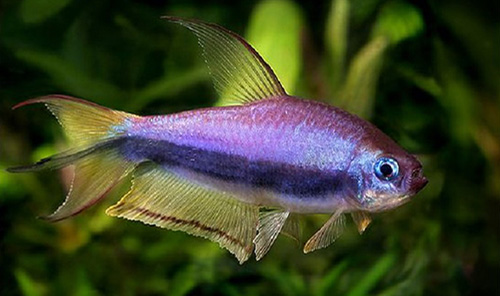 |
|
| Phylum | Chordata | Class | Actinopterygii |
| Order | Characiformes | Family | Characidae |
| Genus | Nematobrycon | Species | Nematobrycon Palmeri |
6. Cardinal tetra
| Brief description | Abdominal parts: bright red color A horizontal blue light along the body Hard to breed in captivity |
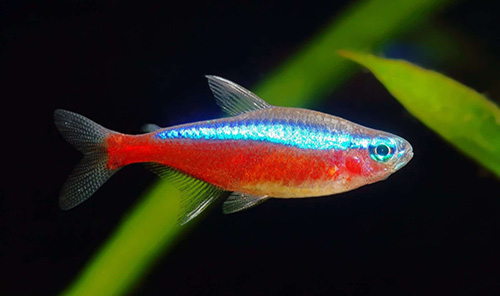 |
|
| Phylum | Chordata | Class | Actinopterygii |
| Order | Characiformes | Family | Characidae |
| Genus | Paracheirodon | Species | Paracheirodon axelrodi |
7. Bloodfin tetra
| Brief description | Body color: silver Dorsal, anal, adipose fins and tail: blood-red color One kind of hardy fish |
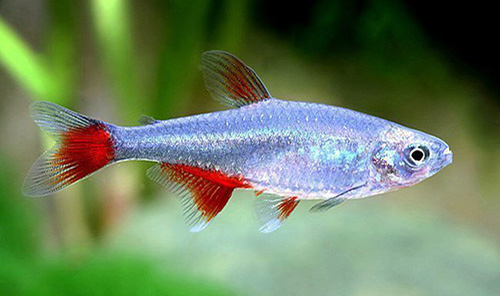 |
|
| Phylum | Chordata | Class | Actinopterygii |
| Order | Characiformes | Family | Characidae |
| Genus | Aphyocharax | Species | Aphyocharax anisitsi |
8. Rummy-nose tetra
| Brief description | Body color: translucent silver Caudal fin: horizontal black and white stripes Head color: dark red, the iris of eyes is also red |
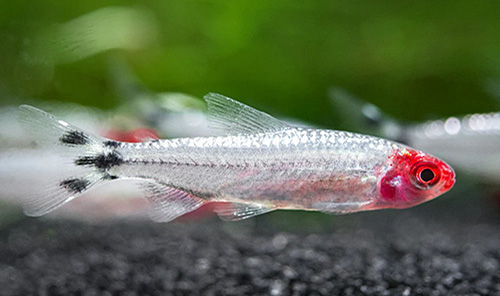 |
|
| Phylum | Chordata | Class | Actinopterygii |
| Order | Characiformes | Family | Characidae |
| Genus | Hemigrammus | Species | Hemigrammus rhodostomus |
9. Black tetra
| Brief description | Body color: black and gray Two vertical bands on the body |
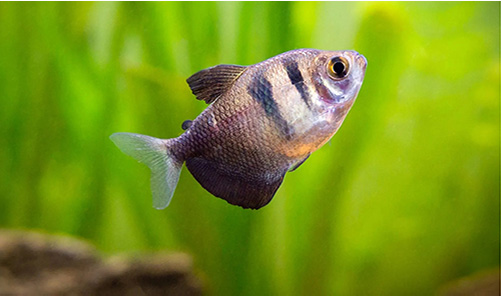 |
|
| Phylum | Chordata | Class | Actinopterygii |
| Order | Characiformes | Family | Characidae |
| Genus | Gymnocorymbus | Species | Gymnocorymbus ternetzi |
10. Redeye tetra
| Brief description | Body color: bright silver Half of the tail: black with white edges Eyes: with a thin red circle |
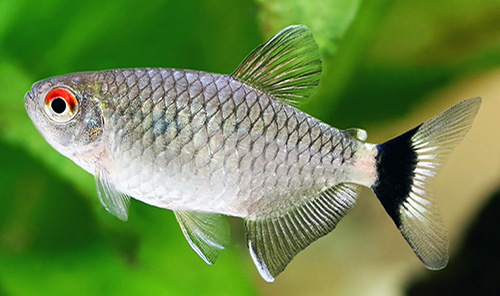 |
|
| Phylum | Chordata | Class | Actinopterygii |
| Order | Characiformes | Family | Characidae |
| Genus | Moenkhausia | Species | Moenkhausia sanctaefilomenae |
Special Types of Tetra Fish
Aside from all the tetras mentioned in the first segment, we would like to share two more special tetras with you, including the Buenos Aires tetra and the South American Green Darter Tropical Tetra. Let’s begin!
1.Buenos Aires Tetra Fish
Buenos Aires tetra is native to South America. It belongs to the Characidae family and Hyphessobrycon anisitsi species. Its body colors are mainly silver and gold, while its fins are orange. Besides, there are black marks on the dorsal fin. The unique feature is the area between the rest of the body and the tail, forming a cross shape with a black color. On the other hand, Buenos Aires Tetra is hardy and ideal for beginners. It is an omnivore. Live and flake food are great options in tetra aquariums.
Likewise, you can feed some live and frozen food, brine shrimp, bloodworms, and daphnia for instance. This tetra can grow to reach over 2 inches and live for 5–6 years. Furthermore, since the tetra fish is great community fish, thus, it is recommended to keep them in a school of five at least.
2. South American Green Darter Tropical Tetra
South American Green Darter tetra is from the Characidiinae family. This tetra prefers living at the bottom, on the rocks, or below aquatic plants. Also, it is easy to keep and friendly to beginners. However, South American Green Darter tetra is not common. For another thing, insects, like fly larvae, are the main food for the tetra. Therefore, you can feed them frozen bloodworms. It can grow up to 1.5-2 inches. In addition, it is peaceful and will not threaten other fish in aquariums. And the tetra likes to live with their kind. Consequently, it is better to keep a school of six at least.
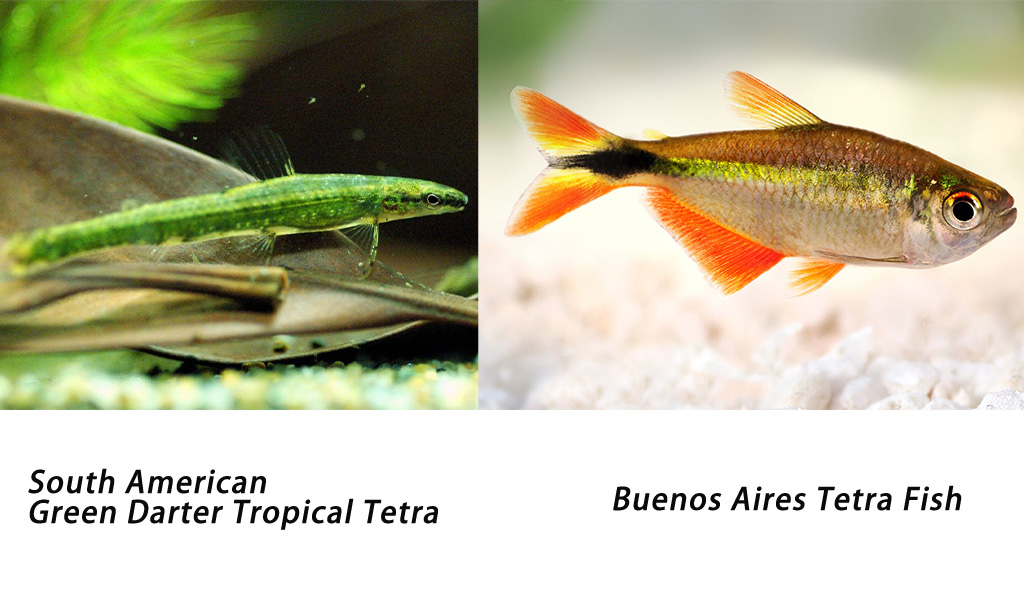
Great Community Tank Tetras
Most tetras are peaceful and are perfect community tank fish. Besides, many tetras can get along well with other species, while also some become a little aggressive. And the amount of schools varies from different tetras. We will give you some ideas about it in the following.
1. Cardinal Tetra
Cardinal tetras are peaceful and can grow up to 2 inches. The minimum tank size should be 20 gallons. Schooling of five is recommended. In addition, they feel enjoyable in warm water. Sterbai corydoras and German blue rams are great tank mates for cardinal tetras.
Requirements for cardinal tetra:
- Water temp: 73-81℉
- pH level:5-7
- Diet: flakes/pellets/live food/brine shrimp/bloodworms/daphnia
2. Congo tetra
Congo tetras can grow up to 2.5 inches. They prefer a school of 6 or more. Although peaceful, a large fish tank is better, like 20 gallons. Meanwhile, Congo tetras like dim light and aquatic plants, for example, java moss.
Requirements for Congo tetra:
- Water temp: 73-82℉
- pH level: 6.0-7.5
- Diet: flakes/pellets/live food/brine shrimp/bloodworms/daphnia
3. Diamond tetra
Also, diamond tetras can reach 2.5 inches and are fond of keeping with 6 or more of their species. But they usually can get along well with other community fish. Moreover, diamond tetras enjoy fish tanks with dim light, plants, and soft water.
Requirements for diamond tetra:
- Water temp: 72-82℉
- pH level: 6-7
- Diet: Dry flakes/pellets/live food/brine shrimp/bloodworms/daphnia
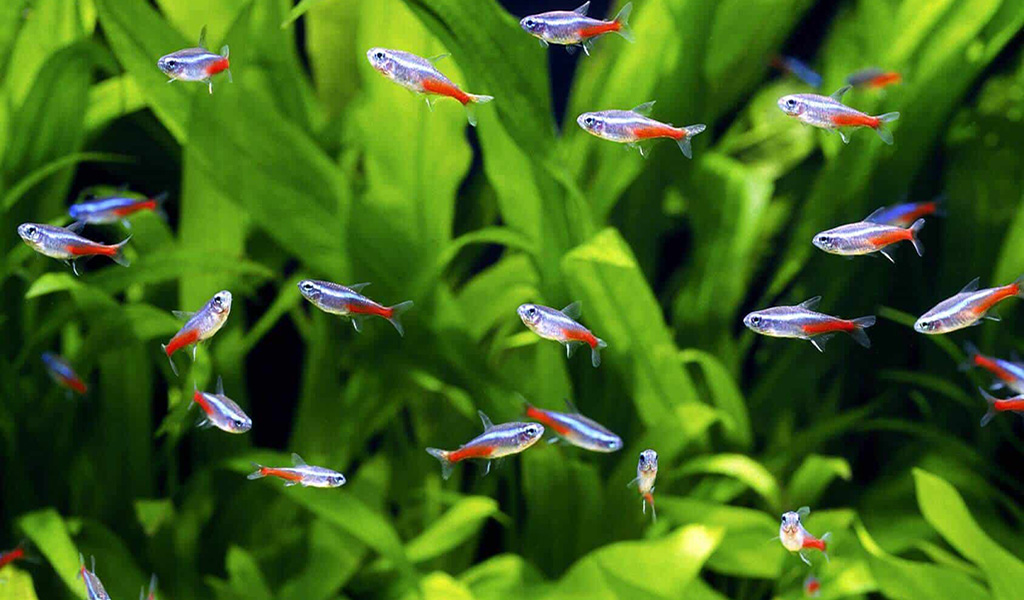
How Long Do Neon Tetras Live
In general, neon tetras can live up to 10 years in the wild and about 5–8 years in the fish tank. Nonetheless, you can extend their lifespan with an ideal diet and proper tank maintenance.
1. Get a large tank
Although neon tetras are small in size, they are community fish and like living with their kind, with a school of six at least. Accordingly, providing a large tank is necessary. Then your neon tetras can swim around the tank and feel comfortable. By the way, a 20-30 gallon tank is one great choice.
2. Keep great water parameters
Whatever fish it is, keeping consistent water temperature is crucial. Sudden water temperature fluctuation is harmful to fish or even causes death. As a result, an aquarium heater is needed. The heater will make sense in maintaining stable water temp. And some heaters can automatically heat up if the temp is lower than the setting range. Besides that, keeping great water quality is another important part. For such cases, except for regular water changes, an aquarium filter will help you out. It helps to remove waste, pollutants, and impurities. Also, you should make sure of sufficient oxygen levels.
Consequently, it is recommended to add an air pump. It will make sense to agitate the water’s surface and then the oxygen can enter the water. Moreover, the ideal water parameters are listed next.
- Water temperature: 69-81℉
- pH level: 6-7
- Hardness level: 2-10 dGH
3. Provide hiding places
Seeing that when neon tetra feels stressed or scared, they may need places to hide. Therefore, to make neon tetra feel safe in the fish tank, it is better to provide hiding places, such as aquatic plants, rocks, and other aquarium decorations such as ornament tree trunks that have holes for small fish to hide.
4. Diet for neon tetra
Neon tetras are omnivore. On the one hand, insect larvae and algae can be food for them. To ensure plenty of nutrients, you can feed pallets, flakes, frozen food, as well as bloodworms and brine shrimp. But do not overfeed. Once or twice each day is feasible.
Final Words
After reading, have you gotten a deeper understanding of tetra fish? Furthermore, here are some guidelines about how to make tetra fry grow quickly, such as setting up a breeding tank and providing proper filtration. If you are likely to share something about Tetra, feel free to leave your ideas in the comment. Finally, thanks for your reading!
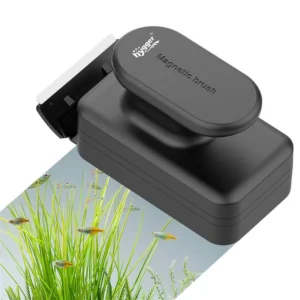
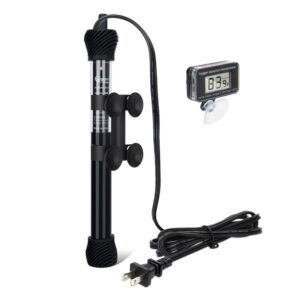
Leave a comment